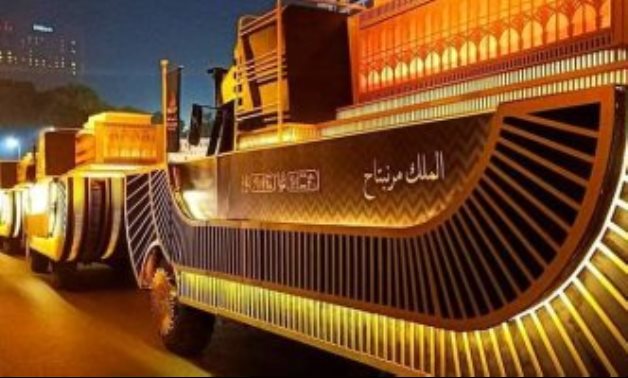
Egypt prepared special cars to transfer Egypt's Royal Mummies during the Royal Parade - Social media
CAIRO – 16 December 2020: The world eagerly anticipates the exit of the 22 kings from the Egyptian Museum in Tahrir, heading to their permanent residence in the National Museum of Egyptian Civilization in Fostat.
That will be done through a huge procession of 22 mummies of the ancient kings of Egypt.
The number of mummies and coffins to be transported is 22 royal mummies and 17 royal coffins, dating back to the 17th, 18th, 19th, and 20th Dynasties. 18 of the mummies are for kings, while 4 belong to queens.
Among the mummies transferred are mummies of King Ramses II; King Seqenenre Tao; King Thutmose III; King Seti I; Queen Hatshepsut; and Queen Meritamen, the wife of King Amenhotep I; and Queen Ahmose Nefertari, the wife of King Ahmose I.
The royal mummies will be transferred to the National Museum of Egyptian Civilization in a large march, in preparation for the opening of three halls that include the central exhibition hall and the mummies hall.
It is worth noting that the National Museum of Egyptian Civilization is one of the most important projects carried out in cooperation with UNESCO and is one of the largest museums of civilization in Egypt and the Middle East.
The procession of royal mummies was preceded by the transferring of 17 sarcophagi of the greatest kings of Egypt, dating back to the era of the 17th, 18th, 19th, and 20th Dynasties, to the National Museum of Egyptian Civilization, in preparation for displaying them with their mummies.
General Director of the Maintenance and Restoration Center at the National Museum of Egyptian Civilization Manal Abdel Moneim el-Ghannam said that the sarcophagi were sterilized with "Anoxia" and the 17 coffins were completely restored separately, whether wooden or cardboard coffins.
Ghannam further stated that each mummy will be displayed with its personal collection, which was found inside its tomb, as the museum’s display scenario inside the mummies hall allows visitors to feel as if they were at the western mainland.
Manal Abdel Moneim explained that sterilization work was carried out in several coffins using "Anoxia", and this took from 21 to 26 days. Then, the cleaning, strengthening, and chemical or mechanical restoration works are done according to the needs of each case. Other coffins were cleaned, strengthened or restored using essential oils. The restoration work took about 60 days, because their condition to some extent is distinct, in addition to the experience of the work team at the National Museum of Egyptian Civilization.
Manal Abdel Moneim added that there are a number of coffins that were placed in the Royal Mummies Hall of the Museum, according to the timetable for the museum display scenario, through the Scenario Committee.
Comments
Leave a Comment